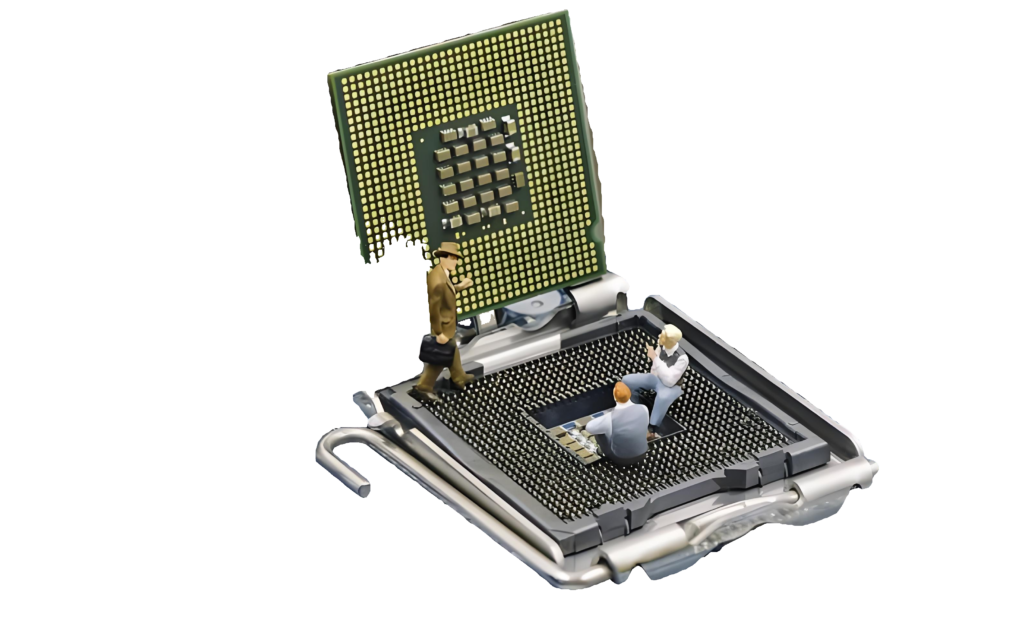BGA Assembly
Comprehensive PCB Assembly Services Customized for You
- Complete PCB Solutions: PCB Fabrication, Component Sourcing, and Assembly
- Flexible Options: Kitted Parts, Partial Turnkey, and Full Turnkey Services
- Versatile Assemblies: Rigid, Flex, and Rigid-Flex PCB Assembly
- Advanced Techniques: Surface Mount Technology (SMT) & Thru-Hole Assembly
- Enhanced Functionality: IC Programming and Conformal Coating
- Scalable Production: From Low to High Volume, with No Minimum Order Quantity (MOQ)
BGA Assembly: Precision in Modern Electronics
The trend of miniaturization in electronics has revolutionized the industry, leading to the creation of devices that are smaller yet more powerful. Consider the evolution of mobile phones, which have transformed from bulky, limited-function devices into sleek, multifunctional smartphones. This shift has dramatically increased the density of components on circuit boards, driving the need for advanced packaging solutions like Ball Grid Array (BGA) assemblies, which enable higher I/O counts and improved performance in compact spaces.
Request Your Free Quote Today!
Understanding BGA Assembly
BGA Assembly involves the precise soldering of BGA chips onto printed circuit boards (PCBs). As a specialized form of Surface Mount Technology (SMT) assembly, BGA assembly requires exceptional precision and expertise. Each chip features hundreds of tiny solder balls that must be accurately aligned and soldered to corresponding pads on the PCB surface. This process demands advanced pick-and-place machinery and highly skilled technicians to ensure top-tier quality.
Surface Mount Technology (SMT) assembly, BGA assembly requires exceptional precision and expertise. Each chip features hundreds of tiny solder balls that must be accurately aligned and soldered to corresponding pads on the PCB surface. This process demands advanced pick-and-place machinery and highly skilled technicians to ensure top-tier quality.
To fully appreciate BGA assembly, it’s important to understand the nature of BGA packages. A Ball Grid Array (BGA) is a type of package that uses a grid of solder balls as connection points, rather than traditional leads. The chip is mounted on a substrate, with the solder balls positioned on the bottom side. These balls serve as the interface between the chip and the PCB, connected through the SMT process.
Types of BGA Assembly
Plastic Ball Grid Array (PBGA): PBGA packages feature a glass-reinforced epoxy substrate, with the die mounted on this epoxy carrier. The term ‘plastic’ refers to the epoxy material used. Inside, wire bonding connects the die to the substrate, with copper traces leading to the solder balls that interface with the PCB.
Ceramic Ball Grid Array (CBGA): In CBGA packages, the substrate is made of ceramic, offering superior hermetic sealing compared to epoxy-based packages. This makes CBGAs ideal for applications requiring high reliability in harsh environments.
Tape Ball Grid Array (TBGA): TBGAs use a flexible or polyimide substrate, paired with high-temperature-resistant solder balls. Copper stiffeners are bonded to the substrate to provide structural support, making TBGAs suitable for applications requiring both flexibility and durability.
Key Advantages of BGA PCB Assembly
Superior Thermal Management BGA packages excel in thermal dissipation, efficiently transferring heat from the chip to the PCB. This capability helps prevent potential overheating, ensuring the longevity and reliability of the device.
Increased Package Density The use of solder balls instead of traditional lead frames allows for greater I/O connectivity and a more compact package size. This optimization maximizes board space, making BGA ideal for applications requiring high density and miniaturization.
Low Signal Distortion Thanks to the absence of leads and the use of solder balls, BGA packages offer low inductance, minimizing signal distortion in high-frequency applications. This provides a significant electrical advantage over leaded packages, especially in performance-critical environments.
Essential Steps in BGA Assembly
BGA assembly is a highly intricate process that demands advanced technology and skilled expertise. Here are the critical stages involved:
Solder Paste Application The process begins with the precise application of solder paste onto the PCB. Ensuring the correct volume and placement is crucial, which is achieved through careful stencil design and optimization of solder printing parameters. Modern solder pastes are lead-free, such as SAC305, which provides robust performance. The PCB itself should feature an Organic Solderability Preservative (OSP) coating and appropriate surface finishes. BGA components typically use two types of solder pads:
Solder Mask Defined (SMD): In this design, the copper pad is larger than the solder mask opening, providing strong adhesion under stress but offering a smaller surface area for the solder ball.
Non-Solder Mask Defined (NSMD): Here, the solder mask opening is larger than the copper pad, exposing the entire pad and offering a different approach to solder ball placement.
BGA Placement Advanced pick-and-place machines are employed to accurately position BGA components onto the PCB. These machines use visual positioning systems and defect inspection tools to ensure precise placement. During the reflow process, BGA components exhibit self-alignment properties, allowing for minor adjustments in positioning.
Reflow Soldering Reflow soldering is a crucial step where the solder paste is heated and cooled in a controlled manner to create solid solder joints. The process involves a specific thermal profile, including ramp-up, flux activation, peak reflow, and cooling phases. Proper control of this process is essential to avoid common defects such as solder bridging, voiding, and poor wetting.
Underfill Dispensing For fine-pitched BGA devices, an underfill material is sometimes applied to enhance reliability. This material fills the gap between the BGA component and the substrate, improving the board’s resilience to thermal and mechanical stress.
Quality Inspection Quality control is paramount in BGA assembly. Automated Optical Inspection (AOI) is widely used to check for alignment and placement accuracy. Additionally, X-ray inspection is conducted to assess solder joint quality, identify voids, and ensure comprehensive solder coverage. This step is crucial for verifying the integrity of the assembly and ensuring optimal performance.
Why Choose LEAPPCB as Your BGA Assembly Partner?
When it comes to BGA PCB assembly in China, LEAPPCB stands out as a reliable choice for efficient, cost-effective manufacturing. With numerous suppliers available, selecting the right partner requires careful evaluation based on key criteria. LEAPPCB, with over 16 years of industry experience, consistently offers advantages that set us apart from the competition.
Quality Assurance As BGA components become increasingly miniaturized and fine-pitched, quality becomes even more critical in the selection of a supplier. LEAPPCB adheres to rigorous documented procedures at every step of the assembly process, fully compliant with customer requirements and international standards such as IPC, ISO, and UL. Unlike many large companies that focus solely on high-volume orders, we have no minimum order quantity limits, ensuring that every order meets our exacting quality standards. When you partner with LEAPPCB, you can trust that quality is never compromised.
Competitive Pricing When evaluating potential suppliers, pricing is often a primary consideration. LEAPPCB offers flexible and competitive quotes, tailored to your specific needs. Our commitment to providing the most cost-effective solutions ensures that you receive the best value without sacrificing quality. We encourage a thorough assessment of our quotes to ensure transparency and avoid any future misunderstandings.
Timely Delivery A reliable BGA PCB assembly partner should offer short lead times and a strong track record of on-time delivery. LEAPPCB boasts an impressive on-time delivery rate exceeding 98%, with a steadfast goal of reaching 100%. We understand the importance of meeting deadlines and strive to ensure that your orders are delivered promptly and efficiently.
Technical Expertise BGA assembly requires advanced machinery and a team of skilled professionals to achieve success. At LEAPPCB, we stay at the forefront of industry developments by continuously upgrading our equipment and investing in new technologies. Whether your project involves complex, precision PCB manufacturing or intricate assembly work, you can trust LEAPPCB to handle it with expertise and care.
Get Your Free Instant Quote Today!
Leap Electronic is your trusted partner and one-stop shop for PCB fabrication, component sourcing, PCB assembly, and electronic manufacturing. With over 16 years of expertise, we proudly serve over 1000 customers worldwide, delivering top-quality PCBs at competitive prices. Our ISO9001:2015 certification and UL listing ensure that all our products meet the highest industry standards. Every PCB is 100% E-tested and inspected using AOI and X-RAY, guaranteeing unparalleled reliability and performance.
Don’t wait – get an instant quote from our sales team today and experience the Leap Electronic difference. We’ll handle the rest!
Frequently Asked Questions about Custom PCB Assembly
A Ball Grid Array (BGA) is a high-density surface-mount packaging technology used in modern electronics. The defining feature of a BGA is the arrangement of its pins, which are ball-shaped and positioned in a grid-like pattern on the bottom of the package, allowing for increased connection density and reliability.
The BGA assembly process is similar to Surface Mount Technology (SMT) assembly. It begins with the application of solder paste onto the BGA pads, followed by the precise placement of BGA chips onto the PCB surface. The process is completed by passing the assembly through a reflow oven, which solidifies the connections and ensures the stability of the BGA chips.
The most common types of BGA components include:
- CBGA (Ceramic Ball Grid Array)
- PBGA (Plastic Ball Grid Array)
- TBGA (Tape Ball Grid Array)
Each type offers unique characteristics suitable for different applications and performance requirements.
BGA is an ideal packaging choice for a wide range of devices, including motherboards, PC chipsets, microprocessors, controllers, ASICs, gate arrays, memories, DSPs, PDAs, and PLDs. If your device requires high performance and compact packaging, BGA is likely the right solution.
The standard solder ball pitch sizes for BGA components typically range from 0.5 mm to 1.0 mm, with some advanced packages featuring pitches as small as 0.3 mm to accommodate high-density designs.
